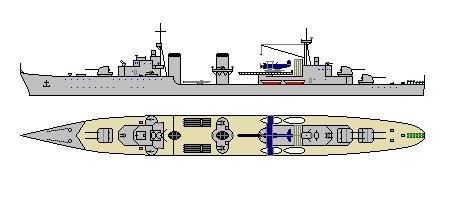The vessel offered meets the power plant and range specifications. Additional length was worked in to allow more room for a hanger. While further increasing dimensions would allow more room, engine requirements would grow rapidly beyond the target range.
The Dutch experience with the placing of aircraft on our smaller destroyers in the 1920s was not overly satisfactory, the seakeeping of of this vessel should aid that issue.
A substantial amount of slack was left in the design, and a high miscellaneous wieght detailed, to allow for specification changes prior to a potential final design.
Escort Cruiser, China Kanoneerbooten laid down 1932
Displacement:
2,135 t light; 2,301 t standard; 2,515 t normal; 2,687 t full load
Dimensions: Length overall / water x beam x draught
408.87 ft / 393.70 ft x 42.65 ft x 11.15 ft (normal load)
124.62 m / 120.00 m x 13.00 m x 3.40 m
Armament:
6 - 5.51" / 140 mm guns (3x2 guns), 83.72lbs / 37.97kg shells, 1932 Model
Quick firing guns in deck mounts with hoists
on centreline, all aft, 1 raised mount aft - superfiring
2 - 2.95" / 75.0 mm guns in single mounts, 12.87lbs / 5.84kg shells, 1932 Model
Anti-aircraft guns in deck mounts
on centreline ends, evenly spread, all raised mounts
6 - 2.95" / 75.0 mm guns in single mounts, 12.87lbs / 5.84kg shells, 1932 Model
Anti-aircraft guns in deck mounts
on side ends, evenly spread
16 - 1.57" / 40.0 mm guns (4x4 guns), 1.95lbs / 0.88kg shells, 1932 Model
Anti-aircraft guns in deck mounts
on side ends, evenly spread, all raised mounts - superfiring
4 - 0.52" / 13.2 mm guns in single mounts, 0.07lbs / 0.03kg shells, 1932 Model
Machine guns in deck mounts
on side, evenly spread
Weight of broadside 637 lbs / 289 kg
Shells per gun, main battery: 300
4 - 21.0" / 533 mm above water torpedoes
Armour:
- Belts: Width (max) Length (avg) Height (avg)
Main: 0.98" / 25 mm 255.91 ft / 78.00 m 13.12 ft / 4.00 m
Ends: Unarmoured
Main Belt covers 100 % of normal length
- Gun armour: Face (max) Other gunhouse (avg) Barbette/hoist (max)
Main: 1.18" / 30 mm 0.79" / 20 mm 0.98" / 25 mm
2nd: 0.59" / 15 mm - -
3rd: 0.59" / 15 mm - -
4th: 0.59" / 15 mm - -
- Armour deck: 0.59" / 15 mm, Conning tower: 0.79" / 20 mm
Machinery:
Coal and oil fired boilers, steam turbines,
Geared drive, 3 shafts, 10,269 shp / 7,661 Kw = 23.15 kts
Range 5,000nm at 12.00 kts
Bunker at max displacement = 387 tons (85% coal)
Complement:
176 - 230
Cost:
£0.853 million / $3.410 million
Distribution of weights at normal displacement:
Armament: 80 tons, 3.2 %
Armour: 292 tons, 11.6 %
- Belts: 138 tons, 5.5 %
- Torpedo bulkhead: 0 tons, 0.0 %
- Armament: 27 tons, 1.1 %
- Armour Deck: 124 tons, 4.9 %
- Conning Tower: 3 tons, 0.1 %
Machinery: 328 tons, 13.1 %
Hull, fittings & equipment: 1,235 tons, 49.1 %
Fuel, ammunition & stores: 380 tons, 15.1 %
Miscellaneous weights: 200 tons, 8.0 %
Overall survivability and seakeeping ability:
Survivability (Non-critical penetrating hits needed to sink ship):
4,601 lbs / 2,087 Kg = 55.0 x 5.5 " / 140 mm shells or 1.3 torpedoes
Stability (Unstable if below 1.00): 1.13
Metacentric height 1.8 ft / 0.5 m
Roll period: 13.5 seconds
Steadiness - As gun platform (Average = 50 %): 80 %
- Recoil effect (Restricted arc if above 1.00): 0.55
Seaboat quality (Average = 1.00): 1.60
Hull form characteristics:
Hull has raised forecastle
and transom stern
Block coefficient: 0.470
Length to Beam Ratio: 9.23 : 1
'Natural speed' for length: 22.87 kts
Power going to wave formation at top speed: 48 %
Trim (Max stability = 0, Max steadiness = 100): 50
Bow angle (Positive = bow angles forward): 22.00 degrees
Stern overhang: 6.56 ft / 2.00 m
Freeboard (% = measuring location as a percentage of overall length):
- Stem: 21.29 ft / 6.49 m
- Forecastle (20 %): 21.29 ft / 6.49 m (13.29 ft / 4.05 m aft of break)
- Mid (50 %): 13.29 ft / 4.05 m
- Quarterdeck (15 %): 13.29 ft / 4.05 m
- Stern: 13.29 ft / 4.05 m
- Average freeboard: 14.89 ft / 4.54 m
Ship tends to be wet forward
Ship space, strength and comments:
Space - Hull below water (magazines/engines, low = better): 78.7 %
- Above water (accommodation/working, high = better): 136.1 %
Waterplane Area: 11,320 Square feet or 1,052 Square metres
Displacement factor (Displacement / loading): 141 %
Structure weight / hull surface area: 71 lbs/sq ft or 347 Kg/sq metre
Hull strength (Relative):
- Cross-sectional: 0.98
- Longitudinal: 1.83
- Overall: 1.04
Hull space for machinery, storage, compartmentation is excellent
Room for accommodation and workspaces is excellent
Ship has slow, easy roll, a good, steady gun platform
Excellent seaboat, comfortable, can fire her guns in the heaviest weather
Quoted
A top view will be a day or two away; I'm rather busy with farm chores at the moment.
